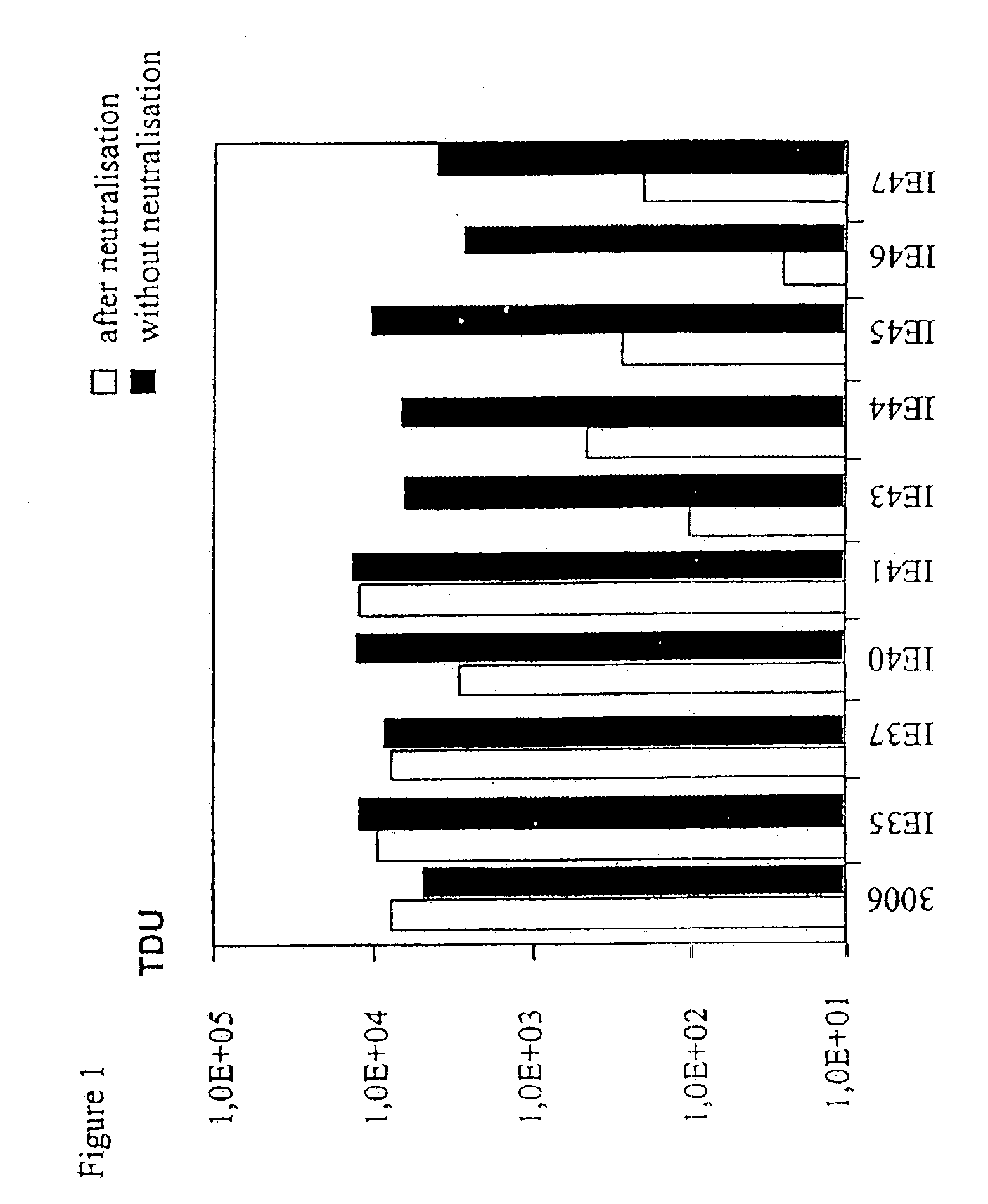Targeted adenovirus vectors for delivery of heterologous genes
a technology of heterologous genes and adenoviruses, which is applied in the direction of vectors, viruses, fusion polypeptides, etc., can solve the problems of affecting the delivery of adenoviral-mediated genes by cells without either the fiber receptor or the penton base receptor, and the reproducible method of targeting
- Summary
- Abstract
- Description
- Claims
- Application Information
AI Technical Summary
Benefits of technology
Problems solved by technology
Method used
Image
Examples
example 1
Manipulation of the Hexon HVR5 Loop of Ad5
[0147]The present example demonstrates that manipulation of the HVR5 loop of Ad5 hexon from amino acids (aa) 269 to 281, keeping intact the most conserved residues at the extremities of the loop (a serine in position 268, and a proline in position 282), unexpectedly provides for effective adenovirus tropism engineering. The sequence removed from the Ad5 hexon was: TTEAAAGNGDNLT (SEQ ID NO: 25) (i.e., our constructs naturally display a threonine to alanine substitution at hexon residue 273 as compared to the published refence sequence of Ad5), and the flanking sequences conserved were FFS (upstream) and PKVV (downstream).
Materials and Methods
[0148]Construction of shuttle plasmids for the manipulation of the HVR5 loop of the hexon. A first intermediate plasmid IE28 containing the flanking regions of the HVR5 loop and in which the HVR5 loop was replaced with the xylE marker gene from Pseudomones putida (Zukowski et al., 1983, PNAS 80:1101-1105)...
example 2
Manipulation of the Fiber HI Loop
[0176]Deletion of the HI loop of the Ad5 fiber was performed: the sequence removed from the fiber knob includes residues 538 to 548 (i.e., sequence GTQETGDTTPS) (SEQ ID NO:72). Its flanking sequences are thus TLN (upstream) and AYS (downstream).
Materials and Methods
[0177]Construction of shuttle plasmids for the manipulation of the HI loop of the fiber. A first intermediate plasmid pJD3 containing the flanking regions of the HI loop and in which the HI loop was replaced with the xylE gene was made using the following two primer pairs:[0178]HIgu1 (5′-CAGCTCCATCTCCTAACTGTAGACTAAATG-3′) (SEQ ID NO:73) and HIgd1 (5′-GGTTACCGGTTTAGTTTTGTCTCCGTTTAA-3′) (SEQ ID NO:74), and[0179]HIdu1 (5′-AGCGCTTACTCTATGTCATTTTCATGGGAC-3′) (SEQ ID NO:75) and HIdd1 (5′-GAGTTTATTAATATCACTGATGAGCGTTTG-3′) (SEQ ID NO:76).
These primer pairs were used to amplify portions of the fiber and E4orf7 genes corresponding respectively to nucleotides 32255 to 32634 and 32712 to 33090 of the...
example 3
Modification of Fiber Protein Length—Short Fibers
[0197]Taking into account the comparison of the cell-binding pathway of Ad5 (a long-fiber serotype) with other serotypes such as Ad9 (a short-fiber serotype), the length of the shaft of the fiber was modified by designing either an intertypic fiber (substitution of the Ad5 shaft by the Ad3, another short-fiber serotype, shaft), or a shortened Ad5 shaft that retained only 6 or 9 repeats instead of 22 in the native protein.
Materials and Methods
[0198]Construction of shuttleplasmids with shortened fibers. Three shuttle plasmids containing shortened fibers were constructed. Two of them (pSF1 and pSF2) display major deletions within the fiber shaft, whereas the third one (pIF1) harbors the Ad3 shaft instead of that of Ad5. All constructs therefore retain the Ad5 tail and knob domains.
[0199]To construct pSF1, two pairs of primers were used:[0200]5M3g (5′-ATTTCTGTCGACTTTATTCAGCAGCACCTC-3′) (SEQ ID NO:110) and[0201]5M3d (5′-GTTTGACTTGGTTTTTTTG...
PUM
| Property | Measurement | Unit |
|---|---|---|
| diameter | aaaaa | aaaaa |
| Tm | aaaaa | aaaaa |
| Tm | aaaaa | aaaaa |
Abstract
Description
Claims
Application Information
 Login to View More
Login to View More - R&D
- Intellectual Property
- Life Sciences
- Materials
- Tech Scout
- Unparalleled Data Quality
- Higher Quality Content
- 60% Fewer Hallucinations
Browse by: Latest US Patents, China's latest patents, Technical Efficacy Thesaurus, Application Domain, Technology Topic, Popular Technical Reports.
© 2025 PatSnap. All rights reserved.Legal|Privacy policy|Modern Slavery Act Transparency Statement|Sitemap|About US| Contact US: help@patsnap.com



